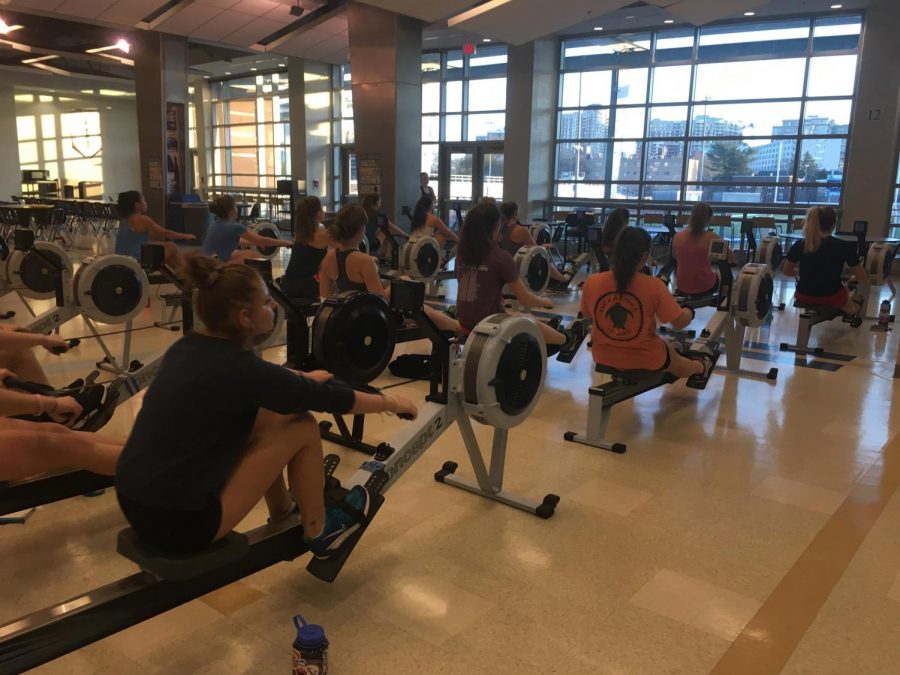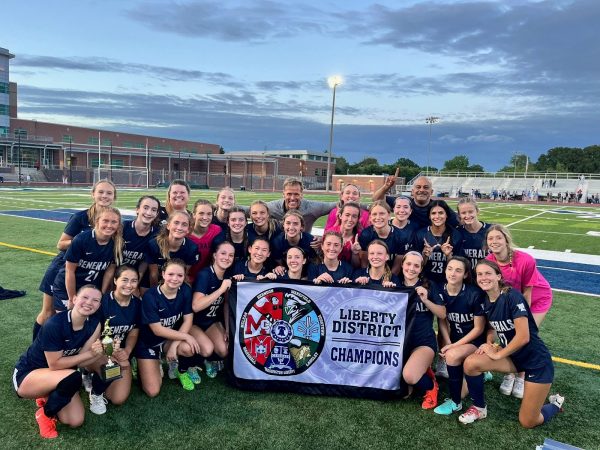A boatload of money
Hard at work, the girls crew team practices rowing on machines called ergometers. The crew team must raise close to 700 dollars per person in funds.
At the back of the cafeteria, rowing machines, called ergometers (ergs), wait in rows. The late afternoon sun trickles in through the wall of windows. The clock chimes 3:30 P.M. and a group of girls begin stretching. Off to the side, boys stand talking and laughing, preparing to begin weight lifting. As the girls climb onto the machines, a song begins to play, steadily growing louder in the background. Voices carry across the expansive room, singing along to the music.
The crew team does not begin holding official practices until spring, but optional conditioning practices are held during the winter season. Team members are strongly encouraged to attend. While all sports teams pay dues, the crew team is different because the amount of dues is more extensive than any other team. Each student must pay dues close to 700 dollars, and fundraise for the team.
“We have two major fundraisers: the wreath sale and the mulch sale,” senior Will Clarke said. “We’ll just go around to houses and ask for either donations or if they want to buy wreaths or mulch, depending on what time of the year it is.”
Wreaths are sold during the winter season and mulch is sold in the spring. While fundraising can be difficult, the sport is, too, and crew members put much of their time and effort into getting better at rowing.
“I think it’s a lot more of a team than any other sport because you’re with your boat [members] all the time for practice, for races, for workouts, so you get to know everyone in your boat really well,” sophomore Aaron Ky-Riesenbach said.
The women’s and men’s crew teams are divided based on skill level. The less experienced rowers follow a different workout routine and are called novices. The experienced are varsity rowers. Despite their skill level, however, all team members must pay dues and help with fundraising.
“I know that if there is a rower that can’t pay their dues, then there are scholarships within the crew team because we want to be able to enable everyone to row,” junior Paige Wheeler said.
Financial aid grants are kept confidential, so much so that even some of the coaches do not know who receives them. All teams must raise money, but not to the same extent as the crew team. The equipment is very expensive. Space in boathouses must be rented, boats must be bought and ergometers, or ergs for short, must be purchased as well.
“We don’t want to turn anyone away who is interested in the sport or who would be a good team member just because they can’t pay the dues,” head women’s coach Dane Underwood said.
Even with the dues and fundraising, coaches can only purchase a certain number of ergs. The women’s and men’s teams, while sticking to their own workout plans, must take turns using the machines. Conditioning practices typically consist of calisthenics, exercises to improve overall fitness, weight lifting, a workout on the ergs, core training and running. Both conditioning and main season practices give students the opportunity to get to know each other and bond through the sport.
“My favorite part of being on the team, I think, is the camaraderie,” Ky-Riesenbach said. “All the friends I’ve made through crew have become my friends outside of crew too.”
Part of becoming a better athlete is taking instruction from coaches and using it to get better, but pushing yourself is just as important when it comes to improving.
“If you want to be great at crew you have to have an internal drive to push yourself and you have to have a great group of guys that will push you,” Clarke said.
Crew is unique, not just in its financial status. What makes it stand out the most is the people involved and the effort those people put in. Practices, in some shape or form, are held during both the winter and spring seasons, making it a bigger commitment than most sports.
“It’s a really good group of people and I have a lot of friends who do it and it’s just a really nice way to spend time with people,” freshman Jana Smith-Perry said.
That time commitment pays off in the end when, during the main season, crew members are at last be allowed to go out on the water.
“The spring is when you get to show off what you’ve done in the winter and all the work you’ve put in. You get to race the other boats and go to different places. It’s really a good time,” Wheeler said.











